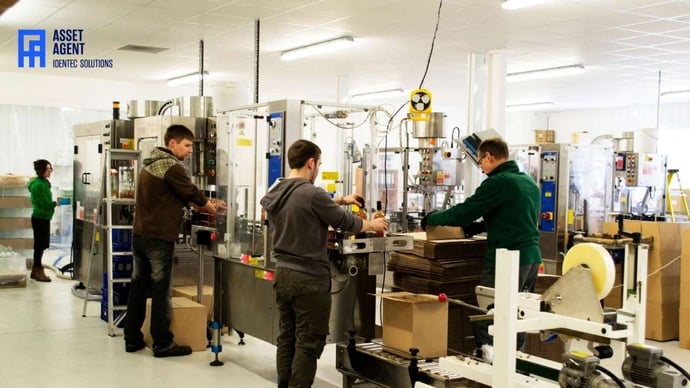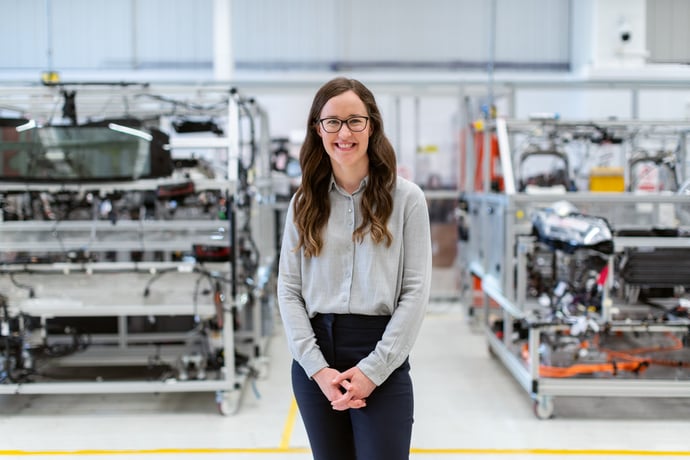The Assembly Line as the Core of Manufacturing
| Written by Mark Buzinkay

No video selected
Select a video type in the sidebar.
The core of an assembly line
The assembly line operates most effectively when product units move down the line one piece at a time rather than in batches. While each unit should flow individually, it is acceptable for a single-unit kit containing all the parts needed for the final product to move through the line together, as the components are all intended for the same product. Although the overall flow of the line is predetermined, the direction of work at individual stations can vary. Tasks may progress from left to right, right to left, or even in both directions when work occurs on both sides of the line, such as in the final stages of car assembly. It is crucial that no backtracking takes place; once a product unit has passed through a station, it should not return, as this disrupts the flow and diminishes productivity. Certain elements, such as instructions, must be available at every station, while other components, like machines or fixtures, may be used as required based on the specific needs of the assembly process.
Therefore, the essential elements that make up an assembly line workstation are:
- Operators
- Machines
- Tools
- Parts
- Product unit & fixture
- One-piece flow
- Instructions
Is the bench better than the assembly line?
It took 150 years after the start of the Industrial Revolution before anyone introduced the assembly line concept. Prior to this, the predominant method was bench assembly, where the product unit remained stationary, and all necessary equipment and parts were brought to it, typically in kits. In this approach, either a single assembler or a team would move around the product to complete the assembly work. While the division of labour is often the first benefit people associate with assembly lines, many other advantages are just as significant. One major benefit is that each component only needs to be delivered to the specific stations where it is actually used rather than to every station. Additionally, the product moves along the line, and each station is responsible for only one operation, eliminating the need for constant setup at every step.
If we consider a scenario where we are producing the same product with a takt time of 100 minutes, both a bench system and an assembly line would require just one operator. However, frequent setup would be necessary with the bench. In contrast, with an assembly line, the operator would simply move the product between stations using a pushcart. Each station would already be permanently set up with the required fixtures, tools, instructions, and parts for a specific task. In reality, the only area where the bench method outperforms the assembly line is in job satisfaction. However, this advantage can diminish even if the bench operator appreciates the greater efficiency of the assembly line.
Where is the bench better?
In both high- and low-volume production, the assembly line generally proves to be more efficient than bench assembly, but there are specific situations where the advantages of the assembly line are negated. One such scenario is the degenerate case, where the assembly process is so simple that the line would consist of only a single station, making it indistinguishable from a bench. This can occur in the low-volume assembly of simple items, such as hand tools with fewer than ten parts.
Another exception arises when the product unit is so small that all of its components can fit on a single bench, and its assembly requires a high level of precision or a "human touch." High-end jewelry, mechanical door locks, and watches are examples where this level of intricacy is needed. Automation would be more suitable than manual assembly if human skills were not required and the production volume was large (see also: Automation of manufacturing process).
A third case involves products too large to move along an assembly line. For example, while sections of a tanker hull or an offshore oil rig can be moved individually, the entire structure is assembled in place within a single dry dock.
Lastly, there are instances where the product is a prototype or a unique, custom system with no similarity to other products made by the company. This is the remaining activity after a P-Q analysis has separated repetitive production. In such cases, there is no defined takt time, and the assembly process itself must be customized. Planning errors are frequent, often leading to components being disassembled and reassembled multiple times during the production process.
Assembly line designs
Not all assembly lines are straight. In fact, long, straight lines are often inefficient. Here are some different types of lines:
All Assembly work done in one single line
In manufacturing, the most straightforward design involves having no subassemblies. All the work is completed in a single, continuous sequence. To ensure smooth coordination and pacing, the only requirement is that each product unit moves to the next station at the designated takt intervals.
Final assembly line with subassembly feeder lines
Within a single sequence of operations, there are often subsequences where only a small part of the product is being worked on, while the rest of the product remains idle, essentially acting as a fixture. In some cases, the product itself may provide poor access to assembled components. It is often much larger than a dedicated fixture would be and not designed to position this subset in a way that makes assembly convenient.
When such inefficiencies are observed, it can be beneficial to consider turning that subset into a subassembly, assembling it on a feeder line with a fixture specifically designed for the task. This approach allows work on the subassembly to happen in parallel with the rest of the product, increasing overall efficiency.
An example is the assembly of car dashboards, which used to be done inside the car body by an assembler working in uncomfortable positions. By moving the dashboard assembly to a separate feeder line, manufacturers can streamline the process, though it introduces the need to coordinate between the feeder line and the main assembly line. Typically, the feeder line has an output buffer from which subassemblies are pulled for use on the main line. However, as the number of feeder lines grows, the complexity of coordinating them increases accordingly.
Modular assembly
Modular assembly involves having suppliers build major subsystems of cars, reducing the workload in final assembly by approximately 90%. This approach is widely used in electronics manufacturing, where the final assembly of products like PCs is straightforward because most of the intricate work has already been done in modules such as motherboards, processor chips, and disk drives, which the suppliers assemble (continue reading about streamlining feeding processes with RTLS solutions).
Assembly line and assembly cells
An assembly cell is a specialized form of an assembly line that can be operated by a team of no more than 8 to 10 operators. Like an assembly line, it offers significant benefits but enhances these by being run by a cohesive team of multifunctional operators. This team-based approach boosts job satisfaction and morale and fosters a heightened awareness of quality. The team manages the release of work to the first step in the sequence and is responsible for ensuring product units are completed at the necessary pace.
Most assembly cells are designed in a U-shape, with the product units moving around a long, narrow work area for the operators. This configuration supports flexible staffing, allowing for easy adjustments in the number of operators based on fluctuations in demand. In a typical U-shaped assembly cell, the operators work inside the U, handling parts that are fed to them from outside the work area. This mode of operation is highly desirable, but not all assembly processes are suited to it. For example, the final assembly of cars, which requires approximately 200 stations, or engine assembly, which involves about 50 stations, do not follow this pattern.
U-shaped cells are best suited for products that are small enough in at least two dimensions to allow for parts to be fed across the assembly stations and do not require simultaneous assembly from multiple sides. While most manufactured goods fit these criteria, important exceptions exist, such as cars, large household appliances, production machinery, or airplanes. In cases where U-shaped cells are impractical, many of their advantages can still be achieved by using "pseudo-U-shaped cells." These cells may feature a different material flow pattern, but they retain the key element of having the operator teamwork inside the cell, preserving the benefits of teamwork and flexibility.
Why convert from an assembly line to an assembly cell?
The following table compares the performance improvements achieved through the use of assembly cells with production in a traditional job shop organized by functional departments. These figures, considered conservative estimates, highlight the benefits of using manufacturing cells.
| Metric | Before | After | Change | Improvement |
| Work-in-Process (units) | 500 | 50 | -450 | 90% |
| Lead time (in work hours) | 100 | 10 | -90 | 90% |
| Units per operator per hour | 5 | 7 | +2 | 40% |
| Space occupied (square feet) | 1000 | 600 | -400 | 40% |
When compared to job-shop production, manufacturing cells offer several key advantages. U-shaped cells significantly enhance operator productivity and flexibility by enabling operators to attend to multiple machines without needing to walk long distances. This arrangement also allows for easy adjustments in the number of operators based on fluctuating work volumes, ensuring that operators can assist one another and exchange information as needed. This promotes a sense of teamwork, which further contributes to efficiency.
Assembly cells also help reduce work-in-process by bringing together tasks that were previously performed at different locations. This eliminates the need for time-consuming moves between departments and reduces queues at entry and exit points. Within the cell, product units move between machines in single pieces or small lots, streamlining the process.
In terms of quality, U-shaped cells improve outcomes by shortening lead times, which in turn minimizes delays in detecting failures. The team-based approach also makes operators responsible for multiple steps in the process, making the consequences of errors more immediately visible, leading to quicker corrections and fewer defects.
Another advantage is the reduction in floor space requirements, as U-shaped cells increase manufacturing density by efficiently organizing work areas.
In comparison to other types of assembly lines, assembly cells stand out because a small, cohesive team operates them. This team is collectively responsible for a larger portion of the assembly process and exercises greater control over the work, leading to higher levels of accountability and collaboration throughout the production process (see also: Industrial process optimization).
FAQ Section: Assembly Line
What is the main difference between an assembly line and an assembly cell?
The main difference lies in the structure and operation. An assembly line is typically a linear sequence where product units move one at a time through various stations, each responsible for a single task. In contrast, an assembly cell is a U-shaped or circular arrangement operated by a small team of multifunctional workers. This team is responsible for multiple tasks, enhancing flexibility and collaboration. While both methods aim to streamline production, assembly cells allow for more teamwork and adaptability to changes in demand, whereas assembly lines are more rigid but efficient for high-volume, repetitive tasks.
How does an assembly cell improve productivity and flexibility compared to a traditional assembly line?
Assembly cells improve productivity by allowing operators to attend to multiple machines in close proximity, minimizing unnecessary movement. This setup supports flexible staffing, meaning the number of operators can be easily adjusted as work volumes change. The team-based nature of assembly cells promotes better communication and teamwork, allowing operators to assist one another and share information more effectively. Additionally, U-shaped cells reduce work-in-process by consolidating tasks into one area, reducing transportation between departments, and enabling the efficient flow of smaller batches.
In what situations would an assembly cell be more beneficial than an assembly line?
Assembly cells are more beneficial for products that are small to medium-sized and don't require complex assembly from multiple sides. They are ideal for situations where flexibility is key, such as in fluctuating production volumes or for products that require more human involvement in the process. Assembly cells also work well when teamwork and multifunctionality are important, as they encourage collaboration and allow operators to handle multiple steps in the process. However, they may not be suitable for large products like cars or airplanes, where the complexity and size require more traditional assembly line setups.
Takeaway
Assembly processes face several challenges, including balancing efficiency with flexibility. While assembly lines are ideal for high-volume production, they can be rigid and less adaptable to changes. In contrast, assembly cells offer greater flexibility and team-based benefits but may not be suitable for large, complex products. Another challenge is managing coordination between feeder lines and the main line, especially as complexity increases. Furthermore, ensuring quality and minimizing errors are critical, as delays in detecting failures can affect overall productivity and output. Ultimately, the choice between methods depends on the product's size, complexity, and production volume.
Delve deeper into one of our core topics: Real time locating system
Glossary
Work-in-process (WIP) units are partially completed goods still undergoing manufacturing processes. They represent products that have started production but are not yet finished and ready for sale. WIP includes raw materials, labor, and overhead costs incurred up to that point. It is a key component of inventory, crucial for evaluating production efficiency and financial statements. WIP management ensures smooth operations by balancing production flow and avoiding bottlenecks. (2)
Sources:
(1) Baudin M., Netland T. (2023): Introduction to Manufacturing. New York: Routledge
(2) Horngren, C. T., Datar, S. M., & Rajan, M. V. (2020). Cost Accounting: A Managerial Emphasis (16th ed.). Pearson.
Note: This article has been updated on the 13th of January 2025

Author
Mark Buzinkay, Head of Marketing
Mark Buzinkay holds a PhD in Virtual Anthropology, a Master in Business Administration (Telecommunications Mgmt), a Master of Science in Information Management and a Master of Arts in History, Sociology and Philosophy. Mark spent most of his professional career developing and creating business ideas - from a marketing, organisational and process point of view. He is fascinated by the digital transformation of industries, especially manufacturing and logistics. Mark writes mainly about Industry 4.0, maritime logistics, process and change management, innovations onshore and offshore, and the digital transformation in general.



